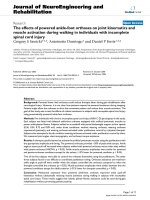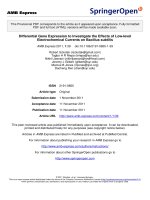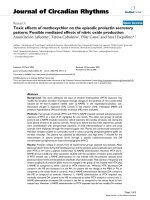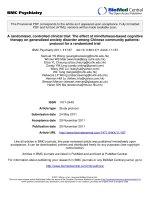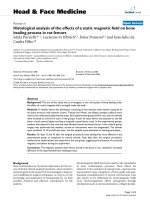The effects of structure based production tasks on english non majored students’ attitudes and grammatical performance
Bạn đang xem bản rút gọn của tài liệu. Xem và tải ngay bản đầy đủ của tài liệu tại đây (1.66 MB, 146 trang )
VIETNAM NATIONAL UNIVERSITY-HO CHI MINH CITY
UNIVERSITY OF SOCIAL SCIENCES & HUMANITIES
FACULTIES OF ENGLIH LINGUISTICS & LITERATURE
THE EFFECTS OF STRUCTURE BASED
PRODUCTION TASKS ON ENGLISH NON-MAJORED
STUDENTS’ ATTITUDES AND GRAMMATICAL
PERFORMANCE
A thesis submitted to the
Faculty of English Linguistics & Literature
in partial fulfillment of the Master’s degree in TESOL
By
NGUYEN QUYNH THY
Supervised by
NGUYEN THU HUONG, Ph.D
HO CHI MINH CITY, NOVEMBER 2017
VIETNAM NATIONAL UNIVERSITY-HO CHI MINH CITY
UNIVERSITY OF SOCIAL SCIENCES & HUMANITIES
FACULTIES OF ENGLISH LINGUISTICS & LITERATURE
THE EFFECTS OF STRUCTURE BASED
PRODUCTION TASKS ON ENGLISH NON-MAJORED
STUDENTS’ ATTITUDES AND GRAMMATICAL
PERFORMANCE
A thesis submitted to the
Faculty of English Linguistics & Literature
in partial fulfillment of the Master’s degree in TESOL
By
NGUYEN QUYNH THY
Supervised by
NGUYEN THU HUONG, Ph.D
HO CHI MINH CITY, NOVEMBER 2017
i
ACKNOWLEDGMENTS
The author would like to express her gratitude and appreciation to those who
have advised, supported and contributed to the completion of the research project.
First of all, I would like to send my greatest gratitude to my supervisor, Dr.
Nguyễn Thu Hương, for his valuable guidance, advice and encouragements. His kind
support, explanations, and comments have encouraged me to complete the project. In
addition, he supplied me with useful sources of materials in language teaching and in
doing research. I owed him for his time helping me with statistical analyses of the data
and discussing the results with me. Without his excellent academic guidance, my
thesis would not have been possible.
Next, I am grateful to my friends and colleagues Ms. Đỗ Ngọc Anh, Ms. Trần
Ngọc Quỳnh Như, and Ms. Châu Thục Quyên for their enthusiastic contributions to
proofreading my thesis, revising the English and Vietnamese versions of the
questionnaire.
I also would like to acknowledge the Head of the Center, Dr. Ngô Thị Thanh
Vân, who allowed me to conduct the study in Tôn Đức Thắng University. Without her
assistance, my thesis would not have been completed.
I would like to thank all of my students who joined in the study for their
valuable time, their great effort to complete a variety of tests and questionnaires. The
thesis would not have been completed without their cooperation.
Finally, I would send my deepest gratitude to my parents who have provided
me with a source of inspiration, motivation and encouragement for me to complete
this research successfully.
ii
STATEMENT OF ORIGINALITY
I certify my authorship of the Master’s Thesis submitted today entitled:
THE EFFECTS OF STRUCTURE BASED PRODUCTION
TASKS ON ENGLISH NON-MAJORED STUDENTS’
ATTITUDES AND GRAMMATICAL PERFORMANCE
in terms of the statement of the Requirements for the Theses in Master’s Program
issued by the Higher Degree Committee. This thesis has not been submitted for the
award of any degree or diploma in any other institutions.
Ho Chi Minh City, November 2017
NGUYEN QUYNH THY
iii
RETENTION AND USE OF THE THESIS
I hereby state that I, NGUYEN QUYNH THY, being the candidate for the
degree of Master of Arts in TESOL, accept the requirements of the University relating
to the retention and use of Master’s Theses deposited in the Library.
In terms of these conditions, I agree that the original of my thesis deposited in
the Library should be accessible for the purposes of study and research, in accordance
with the normal conditions established by the Library for the care, loan, or
reproduction of thesis.
Ho Chi Minh City, November 2017
NGUYEN QUYNH THY
iv
TABLE OF CONTENTS
TITLE PAGE ................................................................................................................. i
ACKNOWLEDGMENTS ............................................................................................ ii
STATEMENT OF ORIGINALITY ...........................................................................iii
RETENTION AND USE OF THE THESIS ............................................................. iv
TABLE OF CONTENTS ............................................................................................. v
LIST OF ABBREVIATIONS ...................................................................................... x
LIST OF TABLES ....................................................................................................... xi
LIST OF FIGURES ...................................................................................................xiii
LIST OF CHARTS .................................................................................................... xiv
ABSTRACT ................................................................................................................ xv
CHAPTER 1: INTRODUCTION ............................................................................... 1
1.1. Background to the study ........................................................................... 2
1.2. Aims of the study ...................................................................................... 3
1.3. Research questions .................................................................................... 3
1.4. Research hypotheses ................................................................................. 3
1.5. Significance of the study........................................................................... 3
1.6. Organization of the study.......................................................................... 4
CHAPTER 2: LITERATURE REVIEW ................................................................... 5
2.1. A brief history of grammar teaching ......................................................... 6
2.2. Issues of grammar teaching....................................................................... 8
2.2.1. Methodological options in grammar teaching .................................. 8
2.2.1.1. Feature-focused options ........................................................... 8
2.2.1.2. Focused communication options .............................................. 9
2.2.2. Procedures......................................................................................... 9
2.2.3. Noticing .......................................................................................... 12
2.2.4. Contexts .......................................................................................... 15
2.2.5. Tasks and activities ......................................................................... 15
2.2.6. Tasks in language teaching ............................................................. 16
v
2.2.7. Grammatical performance .............................................................. 18
2.2.8. Structure Based Production Tasks .................................................. 20
2.3. Previous studies ....................................................................................... 21
2.3.1. Studies on the impact of focused tasks on learners’ grammatical
performance .................................................................................................. 22
2.3.2. Studies on the relationship between focused tasks and students’
attitudes ........................................................................................................ 25
2.4. Conceptual framework ............................................................................ 28
2.5. Chapter summary .................................................................................... 29
CHAPTER 3: RESEARCH METHODOLOGY ..................................................... 30
3.1. Research design ...................................................................................... 30
3.2. Research setting and participants............................................................ 31
3.2.1. Research setting .............................................................................. 31
3.2.2. Sampling ......................................................................................... 31
3.2.3. Participants ..................................................................................... 31
3.3. Instruments.............................................................................................. 32
3.3.1. Tests ................................................................................................ 32
3.3.1.1. Proficiency Test ...................................................................... 32
3.3.1.2. Pre-test .................................................................................... 33
3.3.1.2. The Discrete-point item test .............................................. 33
3.3.1.2.2. The Integrative item test ................................................. 34
3.3.1.3. Post-test .................................................................................. 35
3.3.2 . Questionnaire ................................................................................. 35
3.3.3. Reliability of the questionnaire ...................................................... 37
3.4. Treatment ................................................................................................ 38
3.4.1. Materials ......................................................................................... 38
3.4.2. English Tense and Aspect............................................................... 39
3.4.3. Procedures....................................................................................... 39
3.4.3.1. Pre-stage ................................................................................. 40
3.4.3.2. Implementation stage ............................................................. 40
vi
3.4.3.3. Post-stage ................................................................................ 45
3.5. Data collection ........................................................................................ 46
3.6. Methods of analysis ................................................................................ 46
3.6.1. T-Test .............................................................................................. 46
3.6.2. Bivariate Correlation ...................................................................... 46
3.6.3. Frequency Count and Percentage ................................................... 47
3.6.4. Scoring criteria for the pre-test and post-test ................................. 47
3.7. Chapter summary .................................................................................... 47
CHAPTER 4: RESULTS AND DISCUSSION OF THE FINDINGS ................... 48
4.1. Results ..................................................................................................... 49
4.1.1. Statistical analysis of pre-test results ............................................. 49
4.1.1.1. Statistical analysis of the Discrete-point item pre-test results 49
4.1.1.2. Statistical analysis of the Integrative item pre-test results ..... 49
4.1.2. Statistical analysis of the post-test results ...................................... 50
4.1.2.1. Statistical analysis of the Discrete-point item post-test results ..
.............................................................................................. 50
4.1.2.2. Statistical analysis of the Integrative item post-test results .... 51
4.1.3. Paired Samples T-Test of the Integrative item pre-test and post-test
of the experimental group ............................................................................. 51
4.1.4. Analysis of data in the questionnaire ............................................. 52
4.1.4.1. Statistical analysis of students’ general attitudes towards the
application of the Structure Based Production Tasks ............................... 52
4.1.4.1.1. Statistical analysis of students’ general preference for the
new method ............................................................................................ 52
4.1.4.1.2. Statistical analysis of students’ general attitudes towards
grammar learning and communicating through the Structure Based
Production Tasks .................................................................................... 53
4.1.4.2. Statistical analysis of students’ positive attitudes towards the
application of the Structure Based Production Tasks ............................... 54
4.1.4.2.1. Statistical analysis of student’s confidence of using
Functions ................................................................................................ 55
vii
4.1.4.2.2. Statistical analysis of student’s confidence of using
Tenses ..................................................................................................... 57
4.1.4.2.3. Statistical analysis of student’s confidence of Discussing
topics ...................................................................................................... 59
4.1.4.3. Statistical analysis of student’s affection for the impact of the
Structure Based Production Tasks ............................................................ 60
1.1.4.4. Statistical analysis of students’ negative attitudes on the
impact of the Structure Based Production Tasks ...................................... 63
4.1.4.4.1. Statistical analysis of student’s anxiety about the use of
Functions ................................................................................................ 63
4.1.4.4.2. Statistical analysis of student’s anxiety about the use of
Tenses ..................................................................................................... 65
4.1.4.4.3. Statistical analysis of other factors of anxiety ................ 66
4.1.4.5. One Sample T-Test for general attitude mean ...................... 68
4.1.4.6. Correlation between confidence and anxiety about using the
English Tenses after implementing the Structure-Based Production Tasks
.............................................................................................. 69
4.2. Discussion of the findings ...................................................................... 71
4.2.1. Theme 1........................................................................................... 72
4.2.2. Theme 2........................................................................................... 76
4.3. Chapter summary .................................................................................... 77
CHAPTER 5: CONCLUSION AND RECOMMENDATIONS ............................ 78
5.1. Summary of the main findings ............................................................... 78
5.2. Suggestions ............................................................................................. 79
5.3. Limitations .............................................................................................. 79
5.4. Recommendations for further research ................................................... 80
5.5. Chapter summary .................................................................................... 81
REFERENCES ........................................................................................................... 82
viii
APPENDIX 1: PROFICIENCY TEST ..................................................................... 89
APPENDIX 2: PRE-TEST......................................................................................... 95
APPENDIX 3: POST-TEST .................................................................................... 106
APPENDIX 4A: QUESTIONNAIRE (ENGLISH VERSION) ............................ 117
APPENDIX 4B: QUESTIONNAIRE (TRANSLATED VERSION) ................... 121
APPENDIX 5A: LESSON PLAN (EXPERIMENTAL GROUP) ........................ 126
APPENDIX 5B: LESSON PLAN (CONTROL GROUP) .................................... 129
ix
LIST OF ABBREVIATIONS
CLT:
Communicative Language Teaching
CR:
Consciousness Raising
EFL:
English as a foreign language
e.g. :
For example
ESL:
English as a Second Language
GTM:
Grammar Translation Method
ibid.:
in the same book
i.e. :
That is
L1:
Mother tongue
L2:
Second Language
M:
Mean
SPSS:
Statistical Package for the Social Sciences
P:
Significance (two-tailed)
r:
Pearson Correlation Coefficient
SBPTs: Structure Based Production Tasks
SD:
Standard Deviation
SLA:
Second Language Acquisition
TBLT:
Task Based Language Teaching
x
LIST OF TABLES
Table 3.1. Description of the participants .............................................................. 32
Table 3.3.1.2.1. Description of the Discrete-point Item Test ................................. 34
Table 3.3.1.2.2. Description of the Integrative Item Test ....................................... 34
Table 3.3.2. The aims and constructs of the questionnaire ..................................... 37
Table 3.3.3a. Description of Reliability Statistics of the Pilot questionnaire ......... 38
Table 3.3.3b. Description of Reliability Statistics of the Official questionnaire ...38
Table 3.4.3.2a. Description of task features ........................................................... 42
Table 3.4.3.2b. Summary of detailed treatment for the Experimental group ........ 43
Table 3.4.3.2c. Summary of detailed treatment for the Control group . ............... 44
Table 3.4.3.2d. Summary of the treatment for
the Experimental and Control groups ...................................................................... 45
Table 4.1.1. Summary of the T-Test results for the Pre-test ................................... 49
Table 4.1.1.1. Summary of the T-Test results for the Discrete-point Item Pre-test 49
Table 4.1.1.2. Summary of the T-Test results for the Integrative Item Pre-test ..... 50
Table 4.1.2. Summary of the T-Test results for the Post-test .................................. 50
Table 4.1.2.1. Summary of the T-Test results for the Discrete-point Item Post-test
.................................................................................................................. 51
Table 4.1.2.2. Summary of the T-Test results for the Integrative Item Post-test ... 51
Table 4.1.3. Summary of the Paired Samples T-Test results for the Integrative Item
Pre-test and Post-test ............................................................................................... 52
xi
Table 4.1.4.1.1. Students’ general preference for the new method ......................... 53
Table 4.1.4.1.2. Students’ general attitudes towards grammar learning and
communicating through the Structure-based Production Tasks ............................. 53
Table 4.1.4.2.1. Students’ confidence of using Functions ...................................... 55
Table 4.1.4.2.2. Students’ confidence of using Tenses ........................................... 57
Table 4.1.4.2.3. Students’ confidence of Discussing topics ................................... 59
Table 4.1.4.3. Student’s affection for the new method .......................................... 61
Table 4.1.4.4.1. Student’s anxiety about using Functions ....................................... 63
Table 4.1.4.4.2. Student’s anxiety about using Tenses ........................................... 65
Table 4.1.4.4.3. Student’s anxiety about other factors ............................................ 67
Table 4.1.4.5a. Summaries of One Sample T-Test results for General Attitude Mean
..................................................................................................................... 68
Table 4.1.4.5b. Summaries of One Sample T-Test results for General Attitude Mean
...................................................................................................................... 69
Table 4.1.4.6. Correlation results between student’s confidence and anxiety about
using the English Tenses ......................................................................................... 70
xii
LIST OF FIGURES
Figure 2.1. The process of learning implicit knowledge ......................................... 14
Figure 2.4. Conceptual framework .......................................................................... 29
Figure 4.1.4.6. Scatterplot showing correlation between student’s confidence and
anxiety about using the English Tenses ................................................................ 70
xiii
LIST OF CHARTS
Chart 4.1.4.2. Students’ positive attitudes towards the application of the Structure
Based Production Tasks .......................................................................................... 60
Chat 4.1.4.3. Student’s affection for the impact of the Structure
Based Production Tasks ......................................................................................... 62
Chart 4.1.4.4. Student’s negative attitudes towards the application of the Structurebased Production Tasks .......................................................................................... 68
xiv
ABSTRACT
The main purpose of the current study was to investigate the effectiveness of
the Structure-Based Production Tasks on English non-majored students’ attitudes and
grammatical performance.
This study was a Pre-Posttest Quasi-experimental design. Fifty nine students of
Ton Duc Thang University were conveniently selected and assigned into two groups:
(1) the experimental group and (2) the control group. The experimental group was
introduced with the alternative model (Task-based approach) while the control group
learned with the traditional approach (PPP). The collected data was analyzed to find
out the differences between two groups in terms of the Discrete-point item test and the
Integrative item test. A questionnaire-based survey was also employed to explore
students’ attitudes towards the treatment.
The statistic results revealed that the experimental group did not exceed the
control group although its results were slightly higher than that of the other. However,
the significant difference of the experimental learners in the Integrative item post-test
indicated that the Structure-Based Production Tasks were effective in grammar
teaching. In addition, the experimental group had favorable attitudes towards the
treatment.
Briefly, the results of the study have offered foundations for the intriguing
implications
withdrawn
from
the
study
xv
to
improve
grammar
teaching
CHAPTER 1
INTRODUCTION
Grammar is necessary for language. It is the combination of form and meaning
as learners not only need to focus on forms of the language but also the meanings the
forms convey (Thornburry, 2008). This suggests that grammar should not be ignored
if we do not want to experience communication breakdown or misunderstanding. In a
daily conversation between my student and I (the researcher), my student answered “I
am staying here for two weeks” instead of “I have been staying here for two weeks” in
response to the question “How long have you been staying here?” This instance
emphasizes the importance of grammar in language teaching. Nevertheless, grammar
teaching has been a controversy in language pedagogy. There were periods when
grammar teaching was totally rejected in the classrooms under the influence of
Audiolingual and Direct methods as a reaction to the overemphasis of grammar in the
time of Grammar Translation Method.
Different attitudes to grammar teaching have resulted in various teaching
methods. Arguments favoring grammar teaching state that grammar is of high value
because mastery of forms leads to proficiency in using the target language.
Meanwhile, arguments compelling grammar teaching strongly claim that it makes
sense to teach learners how to use the target language. Consequently, it brings the
question into the foreground of whether learners should only learn grammar or learn
to communicate.
Recently, there has been a revival of grammar teaching with various
approaches. Despite diverse objectives and underlying assumptions, the primary
purpose of grammar teaching is to enable learners to use grammar accurately and
fluently. Under the eye of the researcher in the setting of Ton Duc Thang University,
students have still encountered these problems although they have learned grammar
from high schools to universities. Consequently, it has urged the researcher to carry
out the study.
1
There are six parts in this chapter including: (1) background to the study, (2)
research aims, (3) research questions, (4) research hypotheses, (5) significance of the
study and (6) organization of the study.
1.1 . Background to the study
There are two popular ways of teaching English grammar: (1) deduction and
(2) induction. Deductive approach is known as a top down process that students are
first provided with rules and meaning of grammatical structures and apply those
structures in controlled and free practice. Meanwhile, inductive approach is
considered as a bottom up process that students discover rules through working on
examples and exercises.
Although inductive approach has been used, teacher-fronted approach and
decontextualization have been taken into account. Students first practice some
examples. Then, teachers supplies learners with rules and meaning of target structures.
Next, students applies those structures at the level of the sentence. This practical
reality is due to the pressure of exams on English teachers who have to prepare
students for their written final exams with an emphasis on vocabulary, reading
comprehension and isolated grammar. Consequently, students cannot use grammar
accurately and fluently although they spent a lot of time studying English.
The English Tenses and aspects are widely used in oral and written forms.
Although Tenses have been teaching for years, students have still failed to use them.
For example “I doing homework”, “you have sing” are such notable examples. These
mistakes may be the consequences of rule-supplied approach and lack of
contextualized input. Therefore, grammar teaching is biased in favor of form and
decontextualization. Basing on the particular teaching context as well as this gap, the
current study establishes its objectives and research questions as follow.
2
1.2 . Aims of the study
The aims of the thesis are (1) to find out differential impacts of two teaching
models: fluency-to-accuracy versus accuracy-to-fluency by using Structure-based
Production Tasks and (2) to suggest some implications for effective grammar teaching
in Ton Duc Thang University.
1.3 . Research questions
The research project seeks the answers to the following questions:
1. What are the differences in the mastery of the English Tenses between the
group that received the Structure-Based Production Tasks and the group that
received that PPP instruction?
Are there significant differences in the (a) Discrete-point item test and (b)
the Integrative item test of the English Tenses between two groups?
2. What kinds of effects does the treatment have on the experimental group’s
attitudes?
1.4 . Research hypotheses
From the two main research questions, the hypotheses of the study can be as the
followings:
For the first research question, it can be hypothesized that the experimental
group will significantly outperform the control group in the Discrete-point item test
and the Integrative item test.
For the second research question, students may show positive attitudes towards
the application of the Structure-Based Production Tasks. It can be hypothesized that
students with average or above average will be favorable for the application of the
treatment in comparison with those under average level.
1.5 . Significance of the study
From the problems and the aims stated, the thesis may contribute significantly
to the teaching of grammar through the application of the Structure-Based Production
Tasks in Ton Duc Thang University. To the students, the thesis may be of benefit as
3
they are able to master grammatical structures and improve oral abilities. To the
teachers, this thesis may help them have a deep insight into ways of grammar teaching
and choose the most appropriate, useful approach. Finally, some implications and
recommendations withdrawn from the study may raise teachers’ consciousness in
grammar teaching and help them be more flexible, creative and adaptive to different
teaching contexts.
1.6 . Organization of the study
There are five chapters in this research. Chapter 1 introduces the background to
the thesis, statement of the issue, aims of the study, research questions, research
hypotheses and organization of the study. Chapter 2 provides theoretical concepts and
theories, empirical research and a conceptual framework for the procedural process of
the study. Chapter 3 presents the ways of conducting the research such as the
methodology and the research design. Every aspect in the research is mentioned
including research setting, participants, research design, research instruments,
procedures and methods of analysis. Chapter 4 reports the results collected from the
experiment and provides the Discussion of the findings. Finally, chapter 5 gives
conclusions, implications, limitations of the study and recommendations for further
research.
4
CHAPTER 2
LITERATURE REVIEW
Chapter one has provided readers with crucial importance of grammar in
language pedagogy. Due to common problems with rule-supplied approach and
decontextualization, the present research aims to investigate the effects of the
Structure Based Production Tasks on students’ attitudes and grammatical
performance. This chapter presents the theoretical foundation which serves as an
establishment for the conceptual framework of the study.
The chapter starts with an introduction about a brief history of grammar
teaching. Next, issues of grammar teaching are mentioned in terms of methodological
options, procedures, noticing, grammatical performance and ways of assessing
learners’ grammatical performance. Then, tasks and activities in language teaching are
presented, specifically (1) unfocused tasks and (2) focused tasks. Afterwards, the
Structure-Based Production Tasks (SBPTs) and their distinctive features are
described. This chapter ends with previous studies regarding the SBPTs, which is the
central issue of the research.
There has been a revival of grammar teaching in the late 1990s under the
context of different approaches to language teaching. In this research, the StructureBased Production Task, which is an attempt to teach grammar, is such a potential.
Hence, what has happened in grammar teaching? In order to provide the answer to this
question, it is necessary to have a deep insight into a brief history of grammar
teaching.
5
2.1. A brief history of grammar teaching
Grammar Translation Method (GTM) of which the ultimate goal was to read
literary texts or to benefit from mental discipline and intellectual development
dominated language teaching from the mid-eighteenth to the mid-nineteenth centuries.
This method emphasized exclusively formal explanations of grammatical rules and
structures, followed by the translation of texts into and out of the mother tongue.
Thus, grammar was taught deductively. Accuracy was stressed with the expectation of
students’ high attainment in translation owing to “the high priority attached to
meticulous standards of accuracy which, as well as having an intrinsic moral value,
was a prerequisite for passing the increasing number of formal written examinations
that grew up during the century” (Howatt, 1984, p. 132).
Although GTM was widely practiced, there was neither advocate nor grounded
theory for it. In fact, speaking knowledge of a language was not in need. The texts,
which were used to teach foreign languages, were actually the products of people
trained in literature rather than in language applied linguistics or language teaching
(Richards & Rodgers, 2001). As a result, Direct method and Audiolingual method
were emphasized as a critical reaction to GTM and laid foundations for language
teaching. Audiolingual method did present grammar rules like GTM although it
followed a syllabus of grammar structures and rejected explicit grammar teaching.
Instead, rules were taught through habit-formation in which drills and repetition of
sentence patterns for accurate production of the target language were stressed.
Under the influence of SLA theory development, Communicative Language
Teaching (CLT) emerged in 1970s. This approach stressed on meaning and assumed
that “learners would acquire forms and vocabulary naturally during the process of
comprehending and responding to the input” (Hinkel & Fotos, 2008, p. 4). In this
regard, grammar syllabus and explicit rule-giving approach were rejected while
learners’ exposure to comprehensible input was highlighted. As Krashen (1981) points
out that it is not vital to include formal explanation as grammar teaching with attention
to forms has little or no influence on the language acquisition. Krashen distinguishes
the terms “acquisition” and “learning” and argues on the minimal influence of
conscious learning on learners’ performance. With this mind, learners should acquire
6
unconsciously and implicitly through exposure to comprehensible input rather than
learn a language consciously and explicitly.
In general, there has been a dramatic change in grammar teaching. It is of great
importance at first, and is devalued later as CLT is highlighted. The movement has
shifted from teaching grammar based on grammar syllabus together with formal rule
presentation to teaching grammar on the ground of grammar-based syllabus using
pattern-practice drills to teaching communicative syllabus. Put it another way,
grammar teaching has moved its emphasis from “presentation” to “production” - that
is, from top-down approach to bottom-up approach. These changes have led to
different ideas about grammar teaching. While explicit presentation of rules by “a rule
of thumb” can directly lead to the “sense of control over speaking and writing”, it is
built on the “false and simplified assumptions” (Leech, 1994, p. 23). In respect of
Leech’s idea, Presentation-Practice-Production (PPP) model is severely discredited on
the assumption that although it seems comfortable for teachers and has a tangible
lesson goal, it is inadequately powerful and poor in levels of attainment (Skehan,
1996). In addition, although CLT is highly assessed in language teaching, it is
believed to depose grammar as grammar is considered equally accuracy. It puts more
weight on the intelligibility than accuracy in comparison with Audiolingual method
and Direct method (Thornburry, 2008).
In two recent decades, language teaching has witnessed a grammar revival.
This revival is highlighted with (1) focus on form and (2) consciousness raising. As
Thornburry (2008) affirms that “A focus on form may simply mean correcting a
mistake. In this sense, a focus on form is compatible with a Task-based approach”
(p. 24). Similarly, Harmer (2007) verifies that the emphasis of a lesson is tasks rather
than language. Many researchers and curriculum developers (Long, 1991; Long &
Crookes, 1992; Nunan, 1989, 1993; Prabhu, 1987; Robinson, 1996, Skehan, 1996,
1998 as cited in Hinkel & Fotos, 2008, p. 138) also propose that second/ foreign
languages can be effectively taught through a Task-based approach. Thornburry
(2008) also claims that acquisition involves conscious processes in which attention is
indispensible. This is in line with Schmidt (1990) that acquisition is concerned with
consciousness processes. In fact, attention and noticing are features of consciousness7
raising which may not directly lead to the acquisition of grammatical features but may
trigger learner’s mental process and gradually result in accurate and appropriate
production. To have a wider perspective about grammar teaching, the following parts
describe the whole picture.
2.2. Issues of grammar teaching
2.2.1 . Methodological options in grammar teaching
There have been a large number of methodological options with respect to
kinds of techniques and procedures used to teach grammar. Three types of options are
identified: (1) teaching strategies, (2) timing strategies and (3) social strategies, which
“combine in different ways and are evident in all kinds of different techniques and
activities” (Stern, 1992, as cited in Ellis, 1997a, p. 78). Of all options, teaching
strategies which are discussed in terms of three dimensions underlie method
controversies. Teaching strategies are identified as a design feature of grammar
teaching which may affect L2 acquisition. Grammar teaching options, according to
Ellis (1997a), involve feedback options and learner performance options. The former,
which comprises overt and covert feedback, refers to devices used to provide
information about learner’s use of specific grammatical structures. The latter, which
relates to various devices available for eliciting different learner behaviors, includes
the use of a specific grammatical feature and is specified under the terms “feature
focused” and “focused communication”. Both options are such typical examples of
analytic teaching strategies where efforts are made to teach grammar (ibid.).
2.2.1.1 . Feature-focused options
Featured-focused options refer to “the practice of isolating linguistic features,
teaching and testing learners one at a time in association with the structural syllabus
while focused communication options direct learners’ attention to grammatical
features through meaning-based activities” (Ellis, 1997a, p. 81). Their distinction can
be distinguished in terms of (1) intentional learning which involves a deliberate
attempt to learn and (2) incidental learning in which there is an absence of
intentionality to learn but may involve impromptu conscious attention to L2 features
8
(Ellis et al., 2009). A feature-focused option mainly focuses on intentional grammar
learning while a focused communication option primarily pays attention to incidental
grammar learning. With this mind, two types of task directs at incidental learning: (1)
meaning-focused tasks and (2) meaning-focused tasks in combination with some
device to focus learners’ attention to particular linguistic features (Ellis, 1997a).
Although the latter does not require learners to make conscious effort to learn L2
features and may draw learners’ attention to specific linguistic features, it is assumed
to direct at incidental learning rather than intentional learning.
2.2.1.2 . Focused communication options
The other way of teaching grammar is using focused communication options.
The Structured Based Communication Tasks (Loschky & Bley Vronman, 1990,
discussed in Ellis, 1997a), which involve both production and comprehension, are
such instances. These tasks not only require learners to focus on message content but
also attend to particular grammatical knowledge. Three types of tasks are identified:
(1) tasks that make the use of a grammatical structure “natural”, (2) tasks that make
the performance of a task “easier” and (3) tasks that make the use of a grammatical
structure “essential”. While it is simple to design reception and production tasks
where using target structures makes the tasks natural and easier, it is difficult to design
production tasks where the use of specific grammatical structures is “essential” (Ellis,
1997a). For example, when students are asked to work on story-telling tasks, they may
avoid using target structures and reformulate incorrect utterances just as the teacher
requests clarification. In this study, focused communication options with the
application of SBPTs are what the study aims at. So, what are the procedures of
grammar teaching? What follows is an account of procedures.
2.2.2 . Procedures
Two procedures of grammar teaching, which are often discussed in SLA, are
deduction (rule-driven) and induction (rule-discovery). “A deductive approach starts
with the presentation of a rule and is followed by examples in which the rule is
applied” (Thornburry, 2008, p. 29). The advantage of this approach is that it is time9




